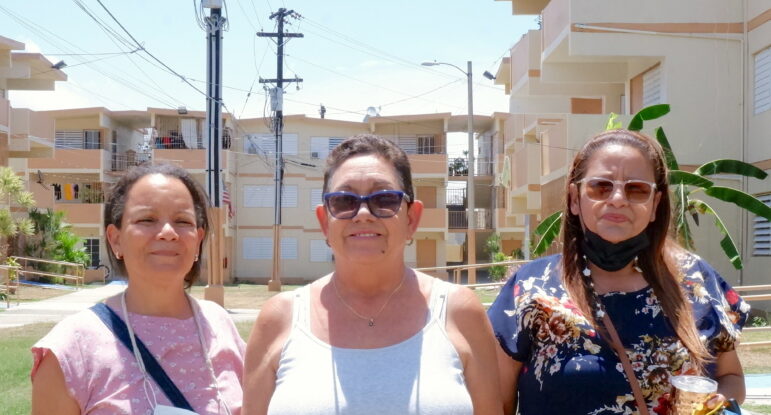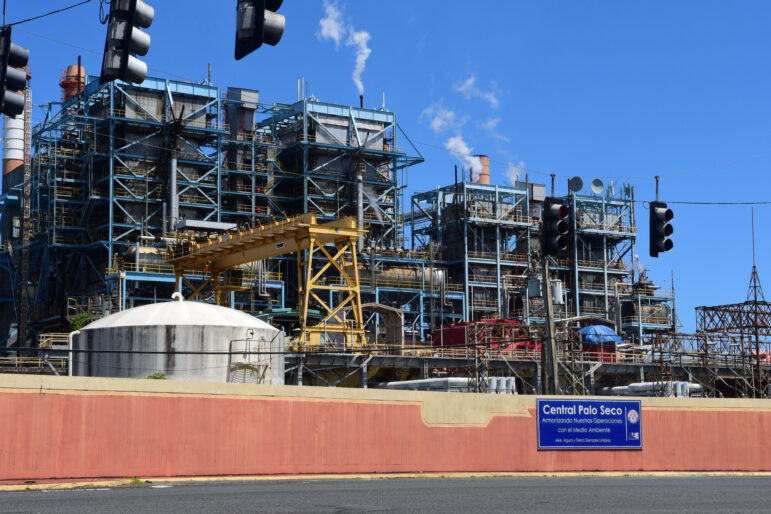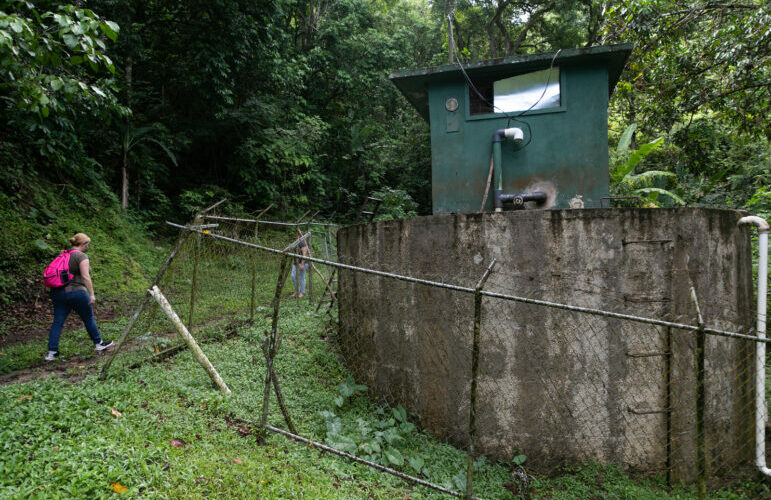Photo by Denis Jones | Metro Puerto Rico
Power plant in Palo Seco, Toa Baja, Puerto Rico.
Fourteen of the 42 monitors that the Department of Natural and Environmental Resources (DRNA, in Spanish) used to measure air pollutants harmful to health throughout Puerto Rico are out of service, some for as long as five years, a Center for Investigative Journalism (CPI, in Spanish) investigation found.
The finding is confirmed by the most recent draft of the DRNA’s 2022 Air Monitoring Network Plan.
There are monitors across the island that measure six pollutants that the Environmental Protection Agency (EPA) identified as harmful to people’s health, especially for those who suffer from asthma, due to their effects on the respiratory, cardiovascular, and even nervous systems. Among the pollutants measured by the monitors are carbon monoxide, sulfur dioxide, as well as two types of particulate matter suspended in the air — dust, ashes, pollen or cement — whose measurement varies according to the diameter of each particle. They also measure ozone, nitrogen dioxide and lead. Some of these chemicals, such as sulfur dioxide, are directly attributed to fuel combustion, while others, such as ozone, appear from a combination of emissions from vehicles, chemical plants, electric power plants, among others.
The monitors out of service are in Bayamón, Cataño, Fajardo, Guayama, Guayanilla, Guaynabo, Juncos, Ponce, Salinas, and San Juan. The lack of data due to inactive stations prevents them from analyzing the complete scope of air pollution in these locations, and the health problems they measure among the residents of those areas related to the pollutants.
The Puerto Rico Asthma Project, managed by epidemiologist Fernando Mercado Ortiz, collected asthma data in 2020 through the Behavioral Risk Factor Surveillance System. Adults ages 55 to 64 and ages 65 and older have the highest prevalence of this respiratory illness, at 11.9% and 11.4%, respectively, the data shows. Among children, the age group of 5 to 9 years had a prevalence of 16%. According to the Code of Federal Regulations, if the index value of the pollutant exceeds 100, these populations are more sensitive to risk, specifically if they are exposed to ozone, particulate matter, sulfur dioxide or nitrogen dioxide.
The absence of 33% of these monitors coincides with the fact that Puerto Rico exceeded the sulfur dioxide standard and non-compliance zones were determined where the Puerto Rico Electric Power Authority’s (PREPA) are located in San Juan, Palo Seco, in Toa Baja, and Aguirre, in Salinas.
On April 11, public hearings were held to adopt a state implementation plan to manage sulfur dioxide in those areas, which proposes installing another six sulfur dioxide monitors in each area and replacing existing fuel with renewable energy and natural gas. State Implementation Plans are required when there is noncompliance with federal standards (NAAQS) and must get the EPA’s approval.
The Puerto Rico Air Monitoring Network, as the DRNA’s 42-monitor system is called, seeks to ensure that the archipelago meets federal standards for each pollutant and keep the population informed about air quality.
Staff shortage aggravates inefficiency of the air monitoring network
In addition to the monitors that are out of service, the network has operational problems due to lack of personnel and budget, according to Lucía Fernández Fontán, head of the DRNA’s Air Monitoring, Validation and Data Management Division of the Air Quality Area (ACAi, in Spanish).
“It is impossible to maintain them with few staff,” said the official, as there are only two field technicians and one electronics technician who perform maintenance weekly or twice a week on the 42 monitors, located in 19 municipalities. The federal recommendation is that they be adjusted manually every three days or that they are given periodical maintenance. Those given maintenance at a different time must have documentation showing which ones were serviced and when the manual adjustments were done. This is impossible to do with three employees. To compensate for the lack of direct data from the monitors, the DRNA uses concentration projections through mathematical modeling, commissioned by two ACAi statisticians.
Amarilys Rosario Ortiz, manager of the DRNA’s Air Quality Area, explained that after Hurricanes Irma and María in 2017, personnel from the program resigned and went to work at the Federal Emergency Management Agency (FEMA). Furthermore, incentivized retirement laws promoted a drop in the workforce between 2015 and 2016, she said.
“We lost 25% of the program’s staff,” she said, adding that they depend on the Office of Human Resources Administration and Transformation and the Office of Management and Budget to recruit staff.
The program works with federal funding proposals. “So far, the funds are available, but the [external approval for recruitment] process is what takes time,” said Rosario Ortiz.
Carmen Guerrero, director of the EPA’s Caribbean Environmental Protection Division, acknowledged that the Puerto Rico Air Monitoring Network does not work efficiently because of the reduced workforce in the DRNA’s Air Program.
“There’s a present shortage of field and laboratory personnel,” she said.
However, Guerrero explained in written statements that not all air monitors work 24 hours a day, 365 days a year, and that they are also subject to periods of maintenance and reprogramming required for the equipment.
Other causes of the monitors’ performance problems include one affected since January 2020 by a traffic accident on the PR-22 highway in Guaynabo, and the delay in the results of the Puerto Rico Environmental Laboratory (PREL) analysis. The most recent plan explains that, when PREL data is delayed, the US EPA’s laboratory conducts the analysis. Although EPA and DRNA Region 2 quality control groups acknowledge these deficiencies, the monitors are still being fixed, the EPA said.
Likewise, the network has been affected due to the delay in installing monitors in new areas, as is the case in Salinas and Guayanilla on the southern coast, where two of the most polluting facilities in the island are located — the AES coal plant and PREPA’s Aguirre plant — and whose monitors have been on the DRNA’s agenda since 2020.
“Yes, there are some stations that we’ve had out of service, others we’ve tried to maintain, precisely because there are stations that have specific purposes,” said Fernández Fontán. The official referred to monitors that measure particulate matter suspended in the air in Guaynabo as a requirement of the State Implementation Plan.
The official also said the delay in the reinstallation of some of these monitors is due to the process of procuring new equipment through the General Services Administration (ASG, in Spanish), the approval and disbursement of federal funds, and the importation of equipment from the United States, which also increases the cost of monitors or parts. The ASG Purchasing and Bids Division stated that the responsibility for monitoring the process falls on the agencies that make the orders.
The manufacturing companies from which the DRNA bought — through the ASG — the equipment to put the monitors into operation are Met-One, Thermo Fisher Scientific and Teledyne Technologies. The latter two have representatives at BioAnalytical Instruments, based in Río Piedras.
BioAnalytical Instruments did not agree to a request for a reaction from the CPI to explain the reasons why the equipment delivery has been delayed and the dates when the purchase orders were received.
“You have to be a supplier for the government of Puerto Rico to be able to buy; so, since these companies are not in Puerto Rico, I cannot buy directly from them,” said the director of the Air Monitoring Division. “I can request a purchase in March, because I need that part, the part may possibly arrive, if I’m lucky, in November or December,” she said.
Fernández Fontán added that the process of repairing the facilities has also been extended because each monitor must have an installation permit from PREPA, which gives the go-ahead for the electrical connection.
She said the station proposed for Salinas, which would measure sulfur dioxide, has already completed this evaluation stage by PREPA and only needs to have the monitor installed. PREPA did not respond to a request from the CPI to provide the status of the monitor and the installation permits that are under consideration.
Environmental attorney Ruth Santiago Quiñones, together with residents of the La Margarita community in Salinas, stressed their concern about the poor air quality that threatens them because of the AES and AEE Aguirre plants. “It’s full of ashes here. They filled the other stretch of highway 701 with ashes,” Santiago Quiñones said. “We’ve seen those emissions from the Aguirre chimneys and from the charcoal furnace in the air… that travels distances,” she added.

Diana Dávila Melero is 67 years old and lives in the La Margarita community. She recounted how she has witnessed construction projects that use shredded tires that “were turned into dust” to mix with soil and use as filler for the area.
“I saw when they filled in all that space where [supermarket] Econo was. I saw when they brought the trucks in with that black stuff [tires]. They came in, flattened it, then later covered it with asphalt,” she said.
As for the Guayanilla station, Fernández Fontán said they had to close it because it was inside an elementary school that was part of the massive closure of school buildings between 2017 and 2018. Four years later, the new location has not been selected, she admitted.
The 2022 plan also proposes moving the monitor that measures the ozone compound in Cataño in the North coast, to an area in the south or southeastern part of the island; adding a nitrogen dioxide station in the same area to compensate for missing data; and adding lead monitors in San Juan and Guayanilla.
Slow funding distribution and approval
According to the federal fund revenue report, the DRNA Air Quality Program received $1.5 million in 2021 and $2.3 million were approved for 2022. This same amount is proposed for 2023.
However, the funds are subject to the allocation and approval of federal agencies or the Office of Management and Budget (OGP, in Spanish), so they are not available for immediate use, according to Fernández Fontán and Rosario Ortiz.
The CPI filed a claim for access to information in court against the DRNA requesting a breakdown of the use of those funds and the amount currently available. The agency has not responded.

Although the 2020 plan states that the EPA received FEMA funding to buy new equipment and replace the damaged monitors after Hurricane María struck, when the CPI consulted the status of the claim with FEMA and how much the requested funds amounted to, the federal agency said it did not have a request related to air monitoring systems in its records. In the case of Clean Air Act funds, they are allocated for permits, inspections, enforcement, quality control, and expenses related to state implementation plans. Uses do not include new vehicles or equipment.
Fernández Fontán estimated that they could apply for $240,000 in US Rescue Plan funds through the EPA and, under the 2022 plan, it would be used to replace old air sampling equipment with new ones. This proposal stems from an EPA project, which will distribute $50 million for air sampling throughout the United States and its territories.
The DRNA’s Interim Secretary Anaís Rodríguez Vega did not respond to a request for an interview from the CPI.
How does the network operate?
The network comprises 42 monitors that measure six pollutants in 19 municipalities. The location of these monitors is chosen according to the criteria of each parameter for each pollutant. For example, Fernández Fontán explained that the stations that measure particulate matter are located where there is more population, due to its health threat. Other parameters depend on the chemical concentrations emitted by certain industries. Ideal concentrations and locations are also estimated based on a dispersion model; it calculates how and where pollutant emissions move into the atmosphere.
However, these location estimates don’t translate accordingly. Fernández Fontán said the metric could establish the location of a station within a mangrove, but the lack of electricity would hold back a successful installation in this type of topography. In addition to electricity, the stations require an air conditioner, the sampling equipment to be indoors, and security for both the monitor and the visiting technicians.
Carl Soderberg, former EPA director for the Puerto Rico and Caribbean region, added that pollutants and their standards are not fixed, but rather are changed according to the needs of the environment and reviewed by the EPA every five years.
The air data that the EPA published in 2022 also reflects the information gap because of the DRNA’s monitors that are out of service.
Despite acknowledging all the challenges facing the network, Fernández Fontán reiterated that this program is “the backbone” of the Air Quality Area, because it determines compliance with federal standards and detects if there are excess contaminants. Puerto Rico has been in noncompliance with the limits of lead in Arecibo, particulate matter in Guaynabo and, recently, sulfur dioxide in Palo Seco and Aguirre, she said.
Soderberg agreed on the importance of the network given the direct relationship it has with people’s health. For that reason, he said this network should be considered an “essential service” in Puerto Rico.
This investigation is the outcome of a grant awarded by the CPI’s Journalism Training Institute and was made possible in part with the support of Para la Naturaleza.

8 septiembre, 2022 LEER MAS